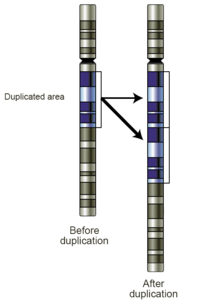
Photo from wikipedia
Abstract Molecular diagnostic investigations, following the identification of foetal abnormalities, are routinely performed using array comparative genomic hybridisation (aCGH). Despite the utility of this technique, contemporary approaches for the detection… Click to show full abstract
Abstract Molecular diagnostic investigations, following the identification of foetal abnormalities, are routinely performed using array comparative genomic hybridisation (aCGH). Despite the utility of this technique, contemporary approaches for the detection of copy number variation are typically based on next-generation sequencing (NGS). We sought to compare an in-house NGS-based workflow (CNVseq) with aCGH, for invasively obtained foetal samples from pregnancies complicated by foetal structural abnormality. DNA from 40 foetuses was screened using both 8 × 60 K aCGH oligoarrays and low-coverage whole genome sequencing. Sequencer-compatible libraries were combined in a ten–sample multiplex and sequenced using an Illumina HiSeq2500. The mean resolution of CNVseq was 29 kb, compared to 60 kb for aCGH analyses. Four clinically significant, concordant, copy number imbalances were detected using both techniques, however, genomic breakpoints were more precisely defined by CNVseq. This data indicates CNVseq is a robust and sensitive alternative to aCGH, for the prenatal investigation of foetuses with structural abnormalities. Impact statement What is already known about this subject? Copy number variant analysis using next-generation sequencing has been successfully applied to investigations of tumour specimens and patients with developmental delays. The application of our approach, to a prospective prenatal diagnosis cohort, has not hitherto been assessed. What do the results of this study add? Next-generation sequencing has a comparable turnaround time and assay sensitivity to copy number variant analysis performed using array CGH. We demonstrate that having established a next-generation sequencing facility, high-throughput CNVseq sample processing and analysis can be undertaken within the framework of a regional diagnostic service. What are the implications of these findings for clinical practice and/or further research? Array CGH is a legacy technology which is likely to be superseded by low-coverage whole genome sequencing, for the detection of copy number variants, in the prenatal diagnosis of structural abnormalities
Journal Title: Journal of Obstetrics and Gynaecology
Year Published: 2019
Link to full text (if available)
Share on Social Media: Sign Up to like & get
recommendations!